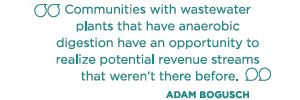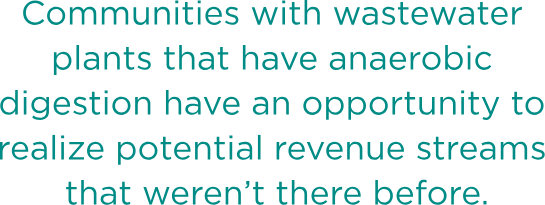Because of advances in technology and supportive regulatory policies, the utilization of biogas now presents new economic opportunities. Municipalities potentially can expand upon service offerings by adding alternative feedstock sources such as FOG into the mix, not only getting rid of unwanted waste streams but also creating larger quantities of renewable biogas in a sustainable manner.





Biogas utilization gives communities new opportunities to meet their environmental goals while also creating the potential for enhanced revenue streams, says Adam Bogusch, a senior project manager at Burns & McDonnell.
“The economics of biogas have changed quite a bit, particularly with regulatory changes that were recently implemented to the renewable fuel standards,” he says. “Communities with wastewater plants that have anaerobic digestion have an opportunity to realize potential revenue streams that weren’t there before. Accepting alternative feedstocks can play a role in these opportunities.”
Businesses or restaurants might be willing to pay wastewater facilities a tipping fee for accepting material, which could include food waste, industrial discharge and other liquid streams. These materials often are problematic or costly for a business to dispose of on its own.
The opportunity for renewable natural gas has also grown as technology has advanced to make this energy source more efficient and affordable on the open market than it has been in years past. When used in vehicles, renewable natural gas generates renewable identification number (RIN) credits that can be sold to refiners to satisfy their renewable fuel mandates; instead of refiners producing renewable fuel on their own, they can buy a credit through other entities such as a wastewater treatment plant.
But to capitalize on these new opportunities, wastewater treatment facilities need the proper infrastructure. Without suitable training and forethought, adding alternative forms of feedstock into a digester can lead to failures and can have costly consequences for an owner.
The addition of alternative feedstocks might make the most sense for facilities that already have anaerobic digesters in place and are producing biogas from more traditional sources. However, caution must still be taken in these applications.
“Even for those with some of the infrastructure in place, potentially taking alternative feedstocks to enhance biogas production requires special equipment to properly handle and process the material, as well as technology to treat and compress the biogas produced,” Bogusch says.
Adding certain materials, such as FOG, to a digester can alter the classification given to the biogas that’s produced, potentially reducing its value in the marketplace for renewable fuel. Ongoing revenues from tipping fees, or utilization of the biogas for other purposes, can help offset these types of impacts.
“It’s important that when considering any of these types of projects, there is a proper analysis conducted that looks at infrastructure, potential revenue streams — whether that’s from alternative feedstock tipping fees or from utilization or sale of the biogas — as well as how ongoing operations and management of new processes will be handled,” Bogusch says.
Want More?
Take a deeper look into how wastewater treatment plants can turn unwanted waste into treasure here.



.png)